The LG G3 Review
by Joshua Ho & Anand Lal Shimpi on July 4, 2014 5:00 AM EST- Posted in
- Smartphones
- LG
- Mobile
- Laptops
- G3
CPU Performance
By now, the Snapdragon 801 is mostly well-understood. It has four Krait 400 cores at either 2.26 or 2.45 GHz, an Adreno 330 at 578 MHz, a faster ISP, DSDA support, and higher clocks on the memory interface, along with support for eMMC 5.0 for faster NAND speed. However, OEM design choices can have significant effects on the relative performance of a device. For example, the Galaxy S5 trailed behind the HTC One (M8) despite a faster SoC due to worse thermal dissipation. This was because water resistance necessitated a new design that effectively encased the SoC in a polycarbonate cage, trapping heat in. The LG G3 has the same SoC and same build materials as the Galaxy S5, but the midframe is magnesium, not polycarbonate. This means that peak performance can be higher than the Galaxy S5.
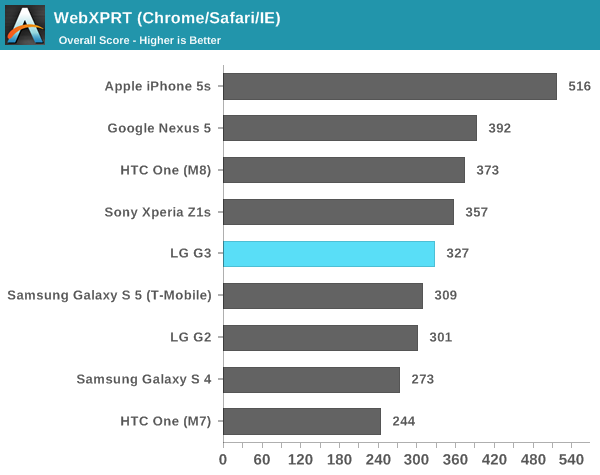
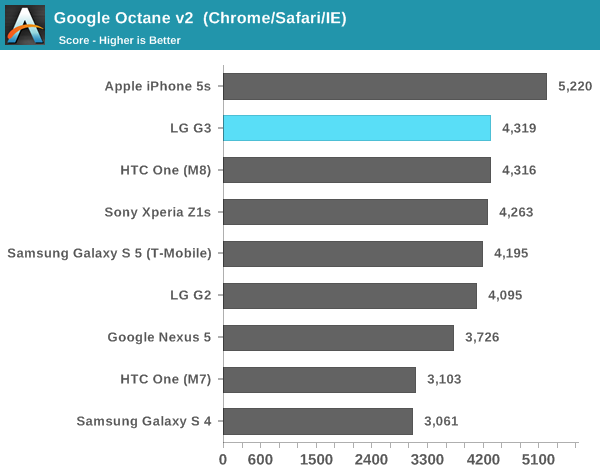
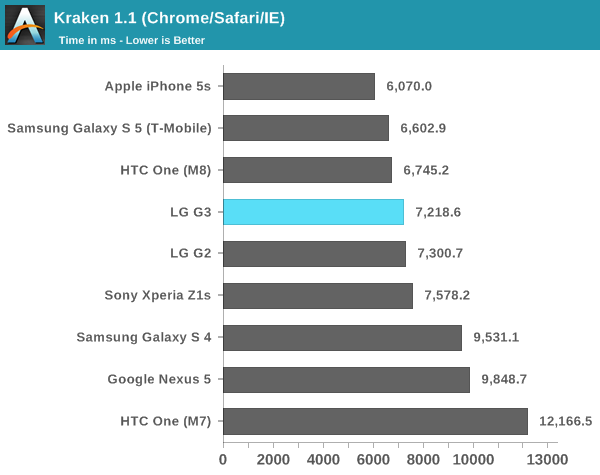
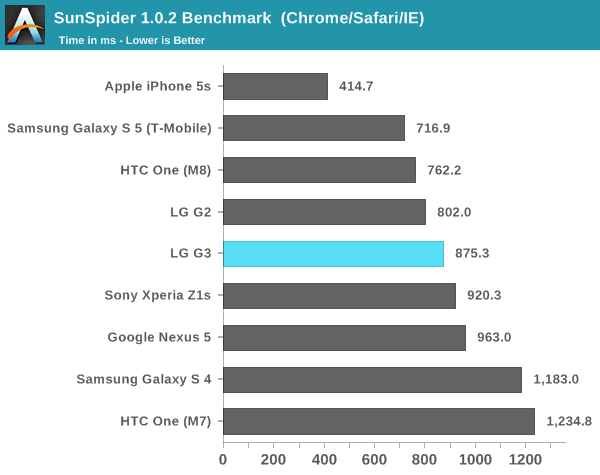
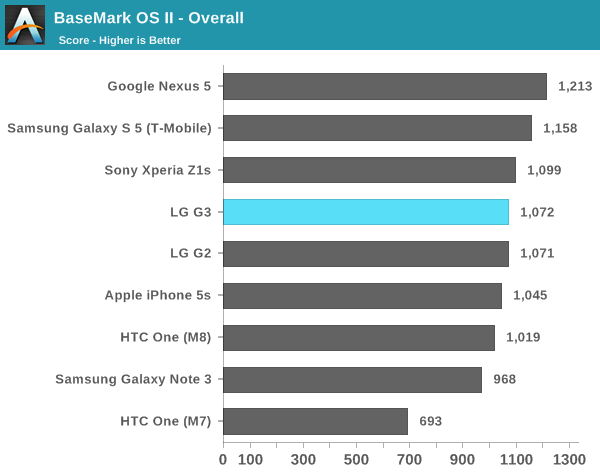
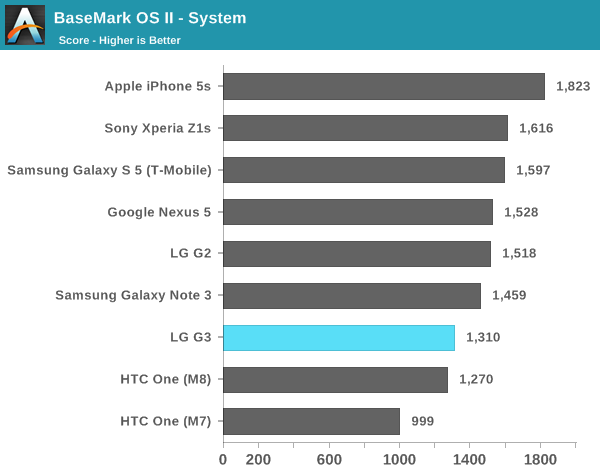
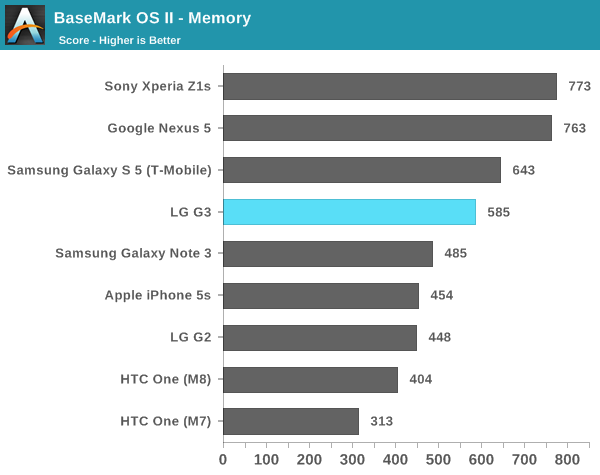

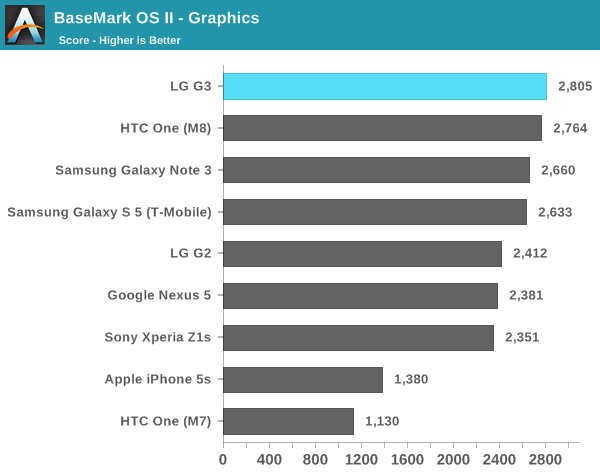
Relatively speaking, there's not much in the way of interesting things to talk about here, despite the new configuration. The G3 seems to trail the other S801 devices in web performance but it seems to depend upon the benchmark. This seems to be partially because of the G3's willingness to throttle, or because of the display's heat output. Either way, the trend is clear because of how often the display brightness is capped to 90 or 95 percent of the maximum to cool off the phone. When this isn't an issue though, the short benchmarks tend to show the faster performance of the G3.
GPU Performance
While the state of CPU benchmarking is heavily subject to difference in the performance of the web browser, things are a bit better in the GPU side. All Snapdragon 801 SoCs have the same GPU clocks, so this means that it'll be much easier to examine throttling behavior and reduce variability due to confounding factors.
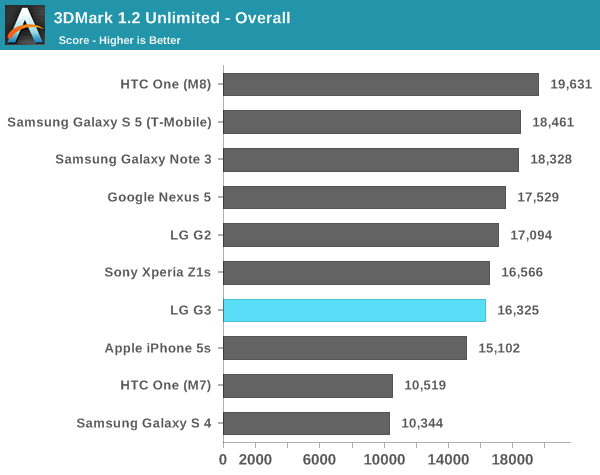
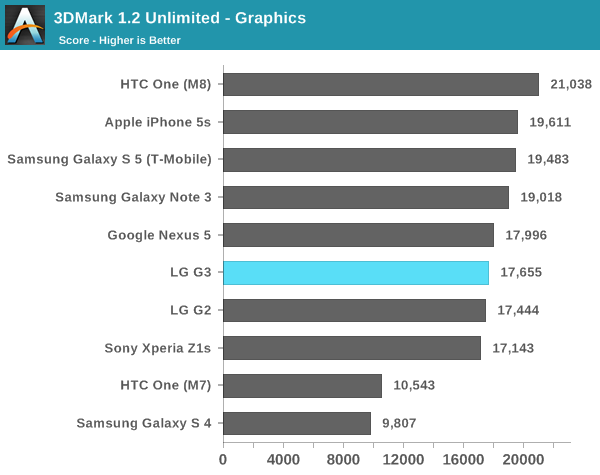

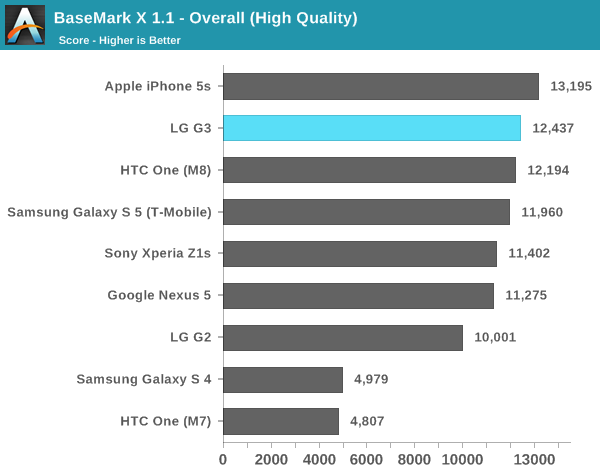
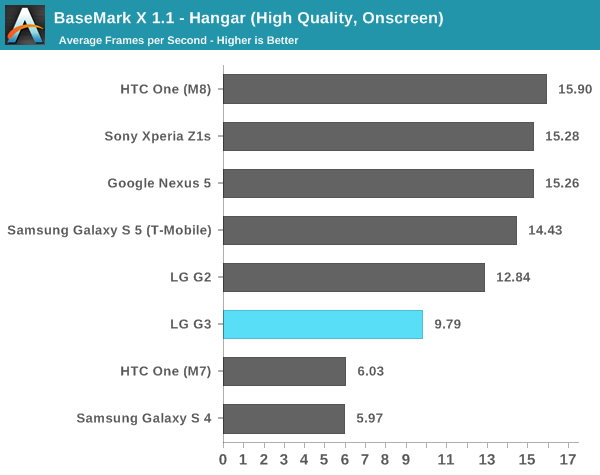
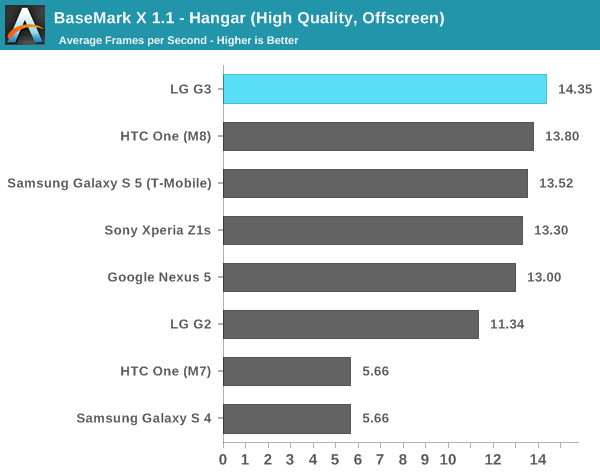
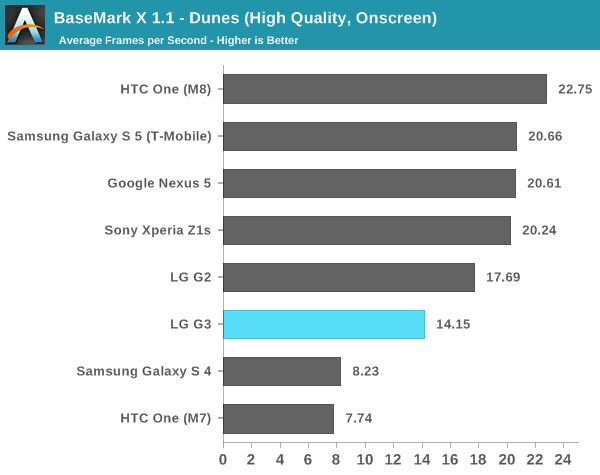
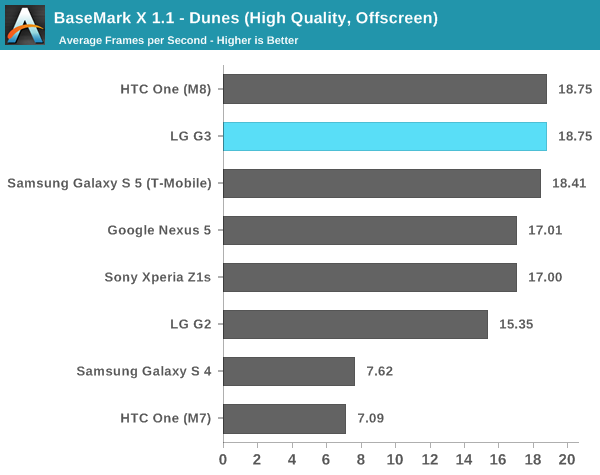
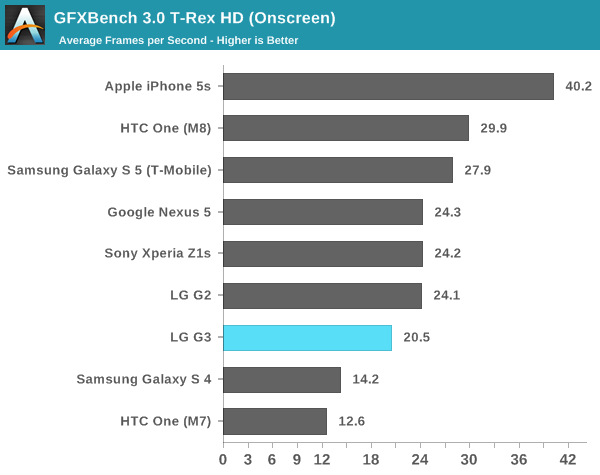
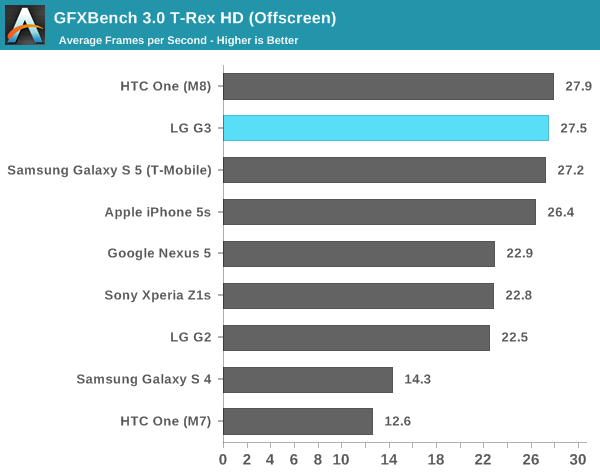
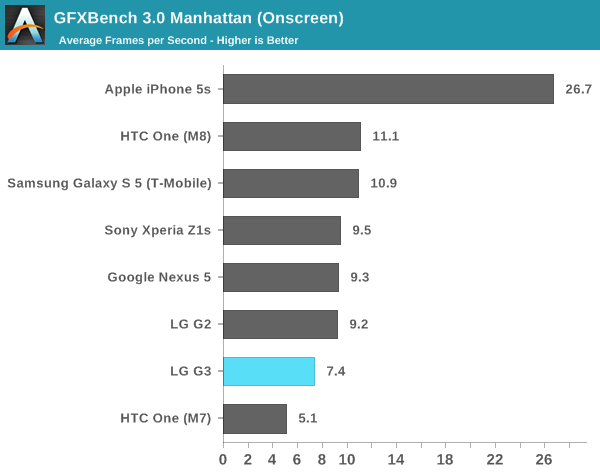
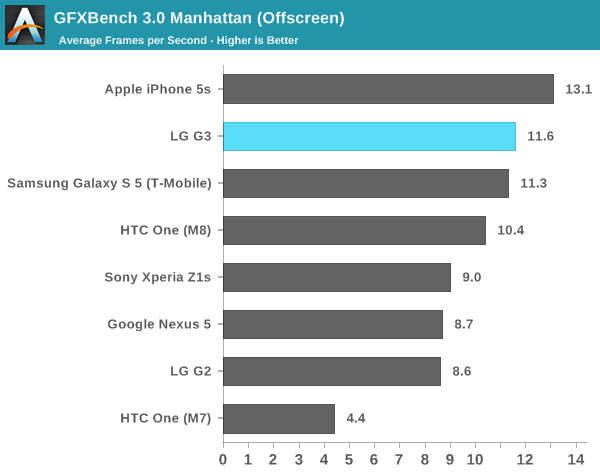
Here, we can see a noticeable trend. In the short tests, the LG G3 does great, easily nearing the top of the scores. However, 3DMark's extremely long-running test means that the G3 noticeably suffers in performance compared to the competition, and this is worsened by the G3's sinusoidal throttling patterns that cause significant degradation of performance for periods of time to balance out the high performance periods. On the on-screen tests, the G3 does worse than the high-end competition, which suggests that QHD/1440p truly does need Snapdragon 805's Adreno 420 in order to keep real-world performance from regressing relative to the Snapdragon 801, 1080p-screened counterparts.
NAND Performance
NAND performance used to be an afterthought, and effectively never discussed in most reviews. However, after the original Nexus 7 revealed the headaches that come with poor I/O performance this metric has increasingly come under greater scrutiny. To quantify this performance, we turn to Androbench with custom settings to evaluate Android smartphones.
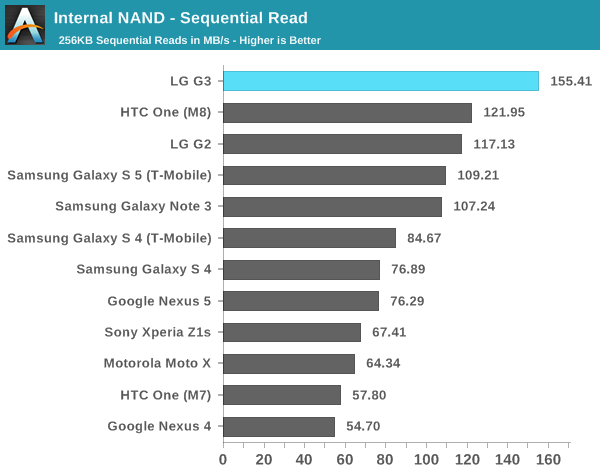
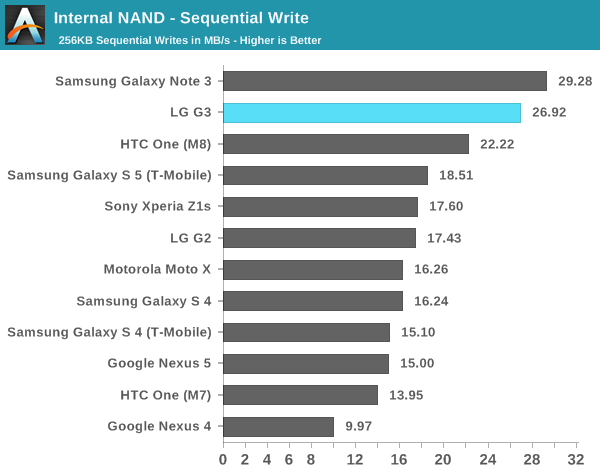
Here, the G3 is off to a great start. The sequential read speeds set new records and sequential write speeds are almost as good as it gets. This means that LG isn't cheaping out on NAND, which means that shooting 4K video and similarly intensive situations won't be a problem on the G3. However, random I/O performance is much more important as that's where people will notice poor performance in the form of stuttering and pauses.

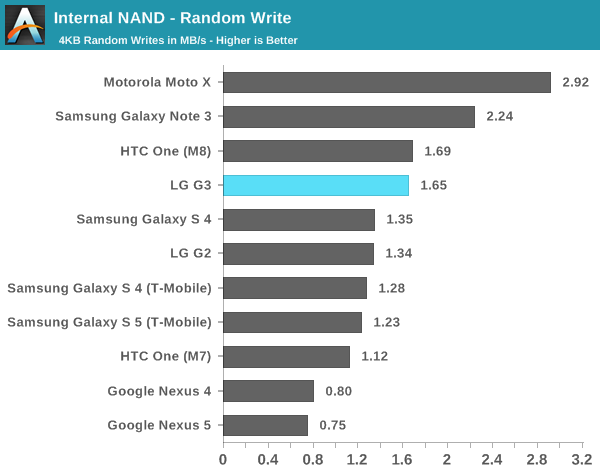
Here, we see a similar pattern. The LG G3 does great in random reads, but random write isn't quite as great. It's still perfectly usable and shouldn't present any problems for smoothness or general performance. The Moto X continues to hold its considerable lead here due to its F2FS file system that allows for much faster random I/O performance. Overall, the LG G3 shouldn't have any issues with I/O pauses, although you should still keep around 25% of your storage open to keep up I/O performance.










174 Comments
View All Comments
SleepyFE - Friday, July 4, 2014 - link
An Android phone works without SIM, so why does pulling it out reset it? Does the flight mode reset it as well?And you can't tell me that's a non-excuse. If you pay 200€ for a phone and you can't use it after a freeze. I would be very pissed off. A power off switch under the cover that physically cuts power would be the best way to go, but no review ever mentioned that, as far as i know.
ZeDestructor - Friday, July 4, 2014 - link
Some form of security perhaps? I just noticed it in the manual where it states that removing the SIM-card from a powered phone will cause it to reboot.If I pay any amount for a phone and it freezes unreacoverably, I would be pissed too, but like I said, there is a key you can press to power off, or you can implement some form of key combo or long-press. Be pissed at the implementation and manufacturer, not the concept.
Besides, just about the only time I've had an android phone lock up was when I overclocked or ran very early custom ROMs, something I don't do since I got a Sony phone, their ROM being so lighweight and bloat-free (admittedly after uninstalling/disabling bundled stuff like facebook) in comparison to the usual Touchwiz/Sense4 bloat
SleepyFE - Friday, July 4, 2014 - link
At the time i did not know about the factory reset button combo, but removing the battery was so easy i didn't give it a second thought (until now). Factory reset means that you have to install all the apps and change the settings. Your google account has that stored but it still takes time to download everything.ZeDestructor - Friday, July 4, 2014 - link
It doesn't do a factory reset, just a hard reboot, similar to what happens when you press the reset button on desktop computers. If it has one...What I would like on the other hand would be that the back cover would be bolted to the frame, rather than glued... means I could swap the battery when it wears out, like current lightweight laptops/ultrabooks have.
SleepyFE - Friday, July 4, 2014 - link
It did a factory reset for me on LG L5. Or maybe i pressed the wrong combo (volume up + power off). Who know anymore. I didn't have to do it since.The possible battery swap sounds perfect. Kind of like a removable battery, but only the cover holds it in place, so the phone can stay thin. Is that what you meant?
ZeDestructor - Saturday, July 5, 2014 - link
Yup. I don't mind pulling wires or carefully avoiding PCBs (And I bloody well should be, given I'm a Computer Engineering student!), and I understand why the batteries are sealed (less redundant casing), but I would like the replaceability to remain. Thus some screws holding things together looks like a good compromise to me: things can stay thin for marketing, I get my repairability, everyone is happy.ZeDestructor - Friday, July 4, 2014 - link
How do you measure up the Sony Xperia Z line? They all have strict "bands" in the phone body for different elements between the screen and the back panel: top is just enough room for a double-sided PCB containing almost all the electronics, the very bottom contains a speaker, microphone, vibrator, camera button and some antennas which leaves the middle as a large battery block, which as of right now is the biggest battery in a non-phablet phone.phoenix_rizzen - Friday, July 11, 2014 - link
Xperia Z: 2330 mAhXperia Z1: 3000 mAh
Xperia Z2: 3200 mAh
G2: 3000 mAh
G3: 3000 mAh
So, out of the complete Z line up, only 1 has a larger battery, and each of the phones is physically larger (taller and wider) with smaller screens (diagonal) than either the G2 or G3.
rxzlmn - Tuesday, July 15, 2014 - link
Well, the current one (who would care about past models?) does have the bigger battery. And the screen has the same diagonal as the G2.H20_mike - Saturday, July 5, 2014 - link
The slight increase in volumetric efficiency doesn't make up for the loss of capacity over time that all LIPO batteries suffer with enough charge cycles. As a heavy user having the option to replace the battery with a new one is a huge benefit. Also nice if buying a used and not knowing the state of the battery.